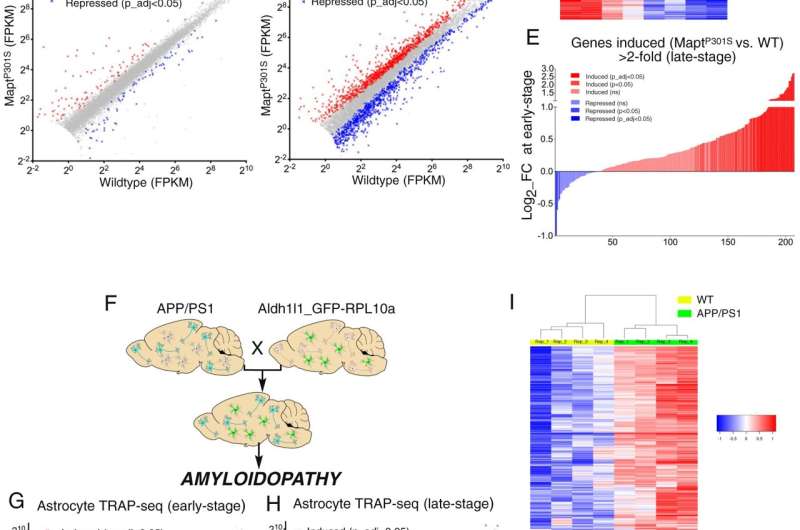Boosting one gene in the brain's helper cells slows Alzheimer's progression in mice

Increasing the expression of one gene in cells that assist the brain's neurons protects neurons in mouse models of Alzheimer's disease.
These findings come from a new study published Jan. 10 in Nature Communications. High activity of the gene, Nrf2, slowed cognitive and physical decline in the mice and reduced the accumulation of sticky proteins in their brains, all key markers of the disease in humans.
The work was led by University of Wisconsin–Madison School of Pharmacy professor Jeffrey Johnson and his collaborators at the University of Edinburgh in Scotland.
Researchers had previously identified Nrf2 as a therapeutic target for Parkinson's disease and amyotrophic lateral sclerosis, ALS. They are now looking for ways to increase the activity of Nrf2 as a potential therapy for Alzheimer's, which has few good treatments and no cure.
The UW–Madison led team discovered that increasing the levels of Nrf2 in support cells called astrocytes helped neurons greatly reduce the accumulation of two disordered proteins at the heart of Alzheimer's.
These proteins, tau and beta-amyloid, form dangerous clumps referred to as tangles and plaques, respectively. The buildup of these proteins stresses neurons and gums up their machinery, leading to neuron death and cognitive decline.
Mice overexpressing Nrf2 performed better on memory and physical tests. Boosting Nrf2 also reversed the genetic signatures of Alzheimer's in the mouse models, suggesting that it had a widespread normalizing effect beyond just addressing the clumps of tau and beta-amyloid.
"The extent of the reduction in beta-amyloid and tau and the nearly complete reversal of the genetic changes is very significant," says Johnson, who helped identify Nrf2's protective role via astrocytes in other neurodegenerative diseases prior to this study. "Over 2,300 genes change in one part of the brain in the Alzheimer's model. And almost all 2,300 go back to normal. I was stunned. I never thought we'd get that outcome."
Nrf2 controls the expression of many genes that protect against insults like oxidative stress or inflammation. It is activated in late-stage Alzheimer's, but its activation may come too late to protect the brain against the disease.
To study how the persistent activation of Nrf2 in astrocytes could protect the brain, Johnson's lab bred mice that both over-accumulated beta-amyloid around neurons, to simulate Alzheimer's disease, and expressed a lot of Nrf2 in astrocytes.
Compared to mice without the boost to Nrf2, those with a lot of the gene had almost 90% less beta-amyloid in their brains. They also had far fewer beta-amyloid plaques.
One symptom of Alzheimer's, both in mice and humans, is memory loss. Alzheimer's model mice overexpressing Nrf2 also performed much better in a classic memory test than those without the boosted gene—nearly as well as non-Alzheimer's mice. And, mice with extra Nrf2 were much better at navigating a tight-rope-like bar, a measure of their balance and coordination.
Collaborator Giles Hardingham at the University of Edinburgh and his team conducted similar experiments on mice that accumulated too much tau protein. They found that tau-heavy mice retained about 25% more neurons when their astrocytes also had boosted Nrf2. These mice also accumulated less tau protein in the cortical neurons of their brains.
"Nrf2 overexpression had a very similar impact in both the tau and beta-amyloid models," says Hardingham. "In both cases, it's very clear that Nrf2 in the astrocytes is modulating the neuropathology."
The research team suspects that Nrf2 boosts neurons' ability to digest these proteins as a way to clear them away. Just how the gene—which is not expressed in neurons but in the supportive astrocytes nearby—performs this feat remains unclear. Plus, Nrf2 seems to provide additional benefits that aren't well understood yet, such as largely reversing disease-associated genetic changes in the brain.
While Nrf2 is an attractive candidate for anti-Alzheimer's treatments, it has proven difficult to activate in the brain using drugs in the past. Johnson says next-generation treatments, such as therapeutic peptides and gene therapy, may be a better way to activate the gene.
Another key component in developing effective treatments for Alzheimer's is diagnosing patients much earlier. Researchers have discovered that Alzheimer's takes many years, perhaps decades, to fully develop. Treating patients at the earliest possible stages may improve their outcomes.
"New diagnostic tools currently under development will be very helpful," says Johnson.
More information: Zoeb Jiwaji et al, Reactive astrocytes acquire neuroprotective as well as deleterious signatures in response to Tau and Aß pathology, Nature Communications (2022). DOI: 10.1038/s41467-021-27702-w





















